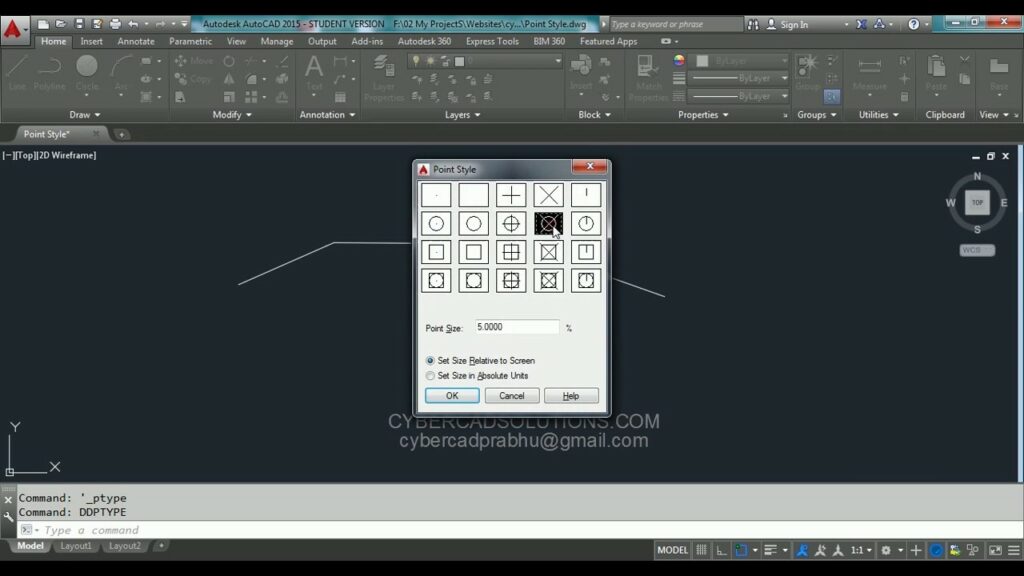Mastering Point Style Customization in AutoCAD: A Comprehensive Guide

AutoCAD, the leading computer-aided design (CAD) software developed by Autodesk, offers an extensive array of tools and features for creating precise and detailed drawings. Among these tools, the ability to customize point styles stands out as a fundamental feature for enhancing visualization and clarity in drawings. In this comprehensive guide, we delve deep into the intricacies of changing point styles in AutoCAD, exploring various methods, techniques, and best practices for optimal customization.
Understanding Point Styles in AutoCAD:
Points in AutoCAD represent specific locations or coordinates within a drawing. By default, points appear as small dots or markers at their designated locations. However, AutoCAD provides users with the flexibility to customize point styles, allowing for variations in size, shape, color, and other attributes to suit specific design requirements and preferences.
Changing Point Style:
AutoCAD offers multiple methods for changing point styles, each tailored to accommodate different user preferences and workflow requirements:
1. Using the POINT Command:
The POINT command in AutoCAD allows users to create single points at specified coordinates or import point data from external sources. To change the point style using the POINT command, follow these steps:
- Type “POINT” in the command line and press Enter to activate the command.
- Specify the insertion point for the new point or input the coordinates manually.
- Press Enter to confirm the insertion point, then select the desired point style from the Point Style dialog box.
2. Modifying Point Settings:
AutoCAD provides a dedicated Point Style dialog box for modifying point settings, including size, shape, color, and other attributes. To access the Point Style dialog box, follow these steps:
- Type “DDPTYPE” in the command line and press Enter to open the Point Style dialog box.
- In the Point Style dialog box, select the desired point style from the list of available styles.
- Customize the point style attributes, such as size, shape, color, and symbol, using the available options and controls.
- Click OK to apply the changes and close the dialog box.
3. Using the Properties Palette:
Alternatively, users can change point styles directly from the Properties palette. To change point styles using the Properties palette, follow these steps:
- Select one or more points in the drawing by clicking on them.
- Open the Properties palette by typing “PROPERTIES” in the command line and pressing Enter or by clicking the Properties button on the Home tab of the Ribbon interface.
- In the Properties palette, locate the Point Style property and select the desired point style from the dropdown list.
- The selected point style will be applied to the selected points automatically.
Key Point Style Attributes:
When customizing point styles in AutoCAD, users can adjust various attributes to achieve the desired appearance and visibility. Key attributes include:
- Size: Specify the size of points in drawing units, controlling their visibility and prominence within the drawing.
- Shape: Choose from a variety of predefined shapes for points, including circles, squares, crosses, triangles, and custom symbols.
- Color: Assign a specific color to points, enhancing visibility and differentiation from other drawing elements.
- Symbol: Select a custom symbol or marker to represent points, allowing for personalized branding or identification within the drawing.
Advanced Techniques:
In addition to basic point style customization, AutoCAD offers advanced techniques and tools for enhancing point visualization and management:
- Point Groups: Organize points into logical groups or categories using point groups, facilitating selective display, editing, and analysis of point data.
- Dynamic Blocks: Create dynamic blocks containing points with customizable attributes, allowing for interactive manipulation and adjustment of point styles within the drawing.
- Point Labeling: Label points with annotations, descriptions, or attribute data using AutoCAD’s text and labeling tools, enhancing clarity and understanding of point locations and properties.
- Point Filters: Define point filters to streamline point selection and manipulation, enabling users to isolate specific subsets of points based on criteria such as location, elevation, or feature type.
Best Practices:
To achieve optimal results when changing point styles in AutoCAD, it’s essential to adhere to the following best practices:
- Plan and Test: Before making changes to point styles, carefully plan the desired appearance and attributes of points, testing different styles and configurations to ensure suitability and effectiveness.
- Consistency: Maintain consistency in point styles throughout the drawing, using uniform attributes and settings to enhance readability and visual coherence.
- Accessibility: Consider accessibility and readability factors when selecting point styles, choosing sizes, shapes, and colors that are easily visible and distinguishable, especially in complex drawings or dense point clouds.
- Documentation: Document point style settings and configurations in drawing templates or project standards documentation, ensuring consistency and repeatability across multiple drawings and projects.
- User Training: Provide training and guidance to users on point style customization techniques and best practices, empowering them to effectively utilize point styles and leverage their full potential in their drawings and designs.
Conclusion:
In conclusion, changing point styles in AutoCAD is a fundamental skill for enhancing visualization and clarity in drawings. By understanding the various methods, techniques, and best practices for point style customization, users can create customized point styles that meet specific design requirements and preferences. With AutoCAD’s versatile tools and features, designers can achieve precise and effective representation of point data, enhancing communication and understanding in their drawings and designs.







